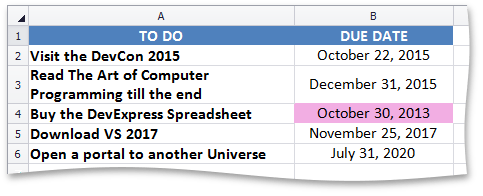How to: Format Cells that Contain Dates
- 2 minutes to read
This example demonstrates how to apply a "date occurring…" conditional formatting rule.
To create a new conditional formatting rule represented by the TimePeriodConditionalFormatting object, access the collection of conditional formats from the Worksheet.ConditionalFormattings property and call the ConditionalFormattingCollection.AddTimePeriodConditionalFormatting method. Pass the following parameters:
- A CellRange object that defines a range of cells to which the rule is applied.
- A time period to be highlighted. This parameter is specified by one of the ConditionalFormattingTimePeriod enumeration values.
- Specify formatting options to be applied to cells if the condition is true using the ISupportsFormatting.Formatting property of the TimePeriodConditionalFormatting object.
To remove the TimePeriodConditionalFormatting object, use the ConditionalFormattingCollection.Remove, ConditionalFormattingCollection.RemoveAt or ConditionalFormattingCollection.Clear methods.
// Create the rule to highlight today's dates in cells B2 through B6.
TimePeriodConditionalFormatting cfRule =
worksheet.ConditionalFormattings.AddTimePeriodConditionalFormatting(worksheet.Range["$B$2:$B$6"], ConditionalFormattingTimePeriod.Today);
// Specify formatting options to be applied to cells if the condition is true.
// Set the background color to pink.
cfRule.Formatting.Fill.BackgroundColor = Color.FromArgb(255, 0xF2, 0xAE, 0xE3);
The image below shows the result. Today’s date in the DUE DATE column is highlighted in pink.
